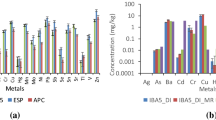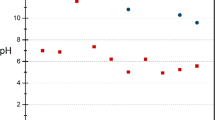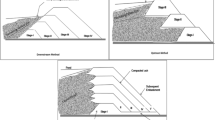Abstract
Apart from the generation of fly ash, brine (hyper-saline wastewater) is also a waste material generated in South African power stations as a result of water re-use. These waste materials contain major species such as Al, Si, Na, K, Ca, Mg, Cl and SO4. The co-disposal of fly ash and brine has been practiced by some power stations in South Africa with the aim of utilizing the fly ash to capture the salts in brine. The effect of the chemical interaction of the species contained in both fly ash and brine, when co-disposed, on the mobility of species in the fly ash–brine systems is the focus of this study. The up-flow percolation test was employed to determine the mobility of some major species in the fly ash–brine systems. The results of the analysed eluates from the up-flow percolation tests revealed that some species such as Al, Ca and Na were leached from the fly ash into the brine solution while some species such as Mg, Cl and SO4 were removed to some extent from the brine solution during the interaction with fly ash. The pH of the up-flow percolation systems was observed to play a significant role on the mobility of major species from the fly ash–brine systems. The study showed that some major species such as Mg, Cl and SO4 could be removed from brine solution using fly ash when certain amount of brine percolates through the ash.





Similar content being viewed by others
References
Adriano, D. C., Page, A. L., Elseewi, A. A., Chang, A. C., & Straughan, I. (1980). Utilization and disposal of fly ash and other coal residues in terrestrial ecosystems: a review. Journal of Environmental Quality, 9, 333–344.
American Coal Ash Association (ACAA) (2011). Coal Combustion Product (CCP) production & use survey report. Website: http://www.acaa-usa.org. Accessed 30 April 2013.
Baba, A., & Kaya, A. (2004). Leaching characteristics of solid wastes from thermal plants of western Turkey and comparison of toxicity methodologies. Journal of Environmental Management, 73, 199–207.
Bock, E. (1961). On the solubility of anhydrous calcium sulphate and of gypsum in concentrated solutions of sodium chloride at 25 °C, 30 °C, 40 °C, and 50 °C. Canadian Journal of Chemistry, 39, 1746–1751.
Bothe, J. V., & Brown, P. W. (2004). PhreeqC modeling of Friedel’s salt equilibria at 23 ± 1 degrees C. Cement and Concrete Research, 34(6), 1057–1063.
Comité Européen de Normalisation (CEN) (2003). prEN14405; leaching behaviour test—up-flow percolation test—Horizontal standard, CEN TC292/WG6.
ESKOM Report (2013). Ash Management in ESKOM, Fact Sheet Number CO 0004. http://www.eskom.co.za. Accessed 22 March 2013.
Fatoba, O. O. (2010). Chemical interactions and mobility of species in fly ash-brine co-disposal systems. PhD Dissertation, University of the Western Cape, South Africa.
Fatoba, O. O., Gitari, W. M., Petrik, L. F., & Iwuoha, E. I. (2011). Fly ash–brine interactions: removal of major and trace elements from brine. Journal of Environmental Science and Health Part A, 46, 1648–1666.
Foner, A. H., Robl, L. T., Hower, C., & Graham, M. U. (1999). Characterization of fly ash from Israel with reference to its possible utilization. Fuel, 78, 215–223.
Georgakopoulos, A., Filippidis, A., Kassoli-Fournaraki, A., Fernández-Turiel, J. L., Llorens, J., & Mousty, F. (2002). Leachability of major and trace elements of fly ash from Ptolemais power stations, Northern Greece. Energy Sources, 24, 103–113.
Gitari, W. M., Petrik, L. F., Etchebers, O., Key, D. L., Iwuoha, E., & Okujeni, C. (2006). Treatment of acid mine drainage with fly ash: removal of major contaminants and trace elements. Journal of Environmental Science and Health Part A, 41, 1729–1747.
Gitari, W. M., Fatoba, O. O., Petrik, L. F., & Vadapalli, V. R. K. (2009). Leaching characteristics of selected South African fly ashes: effect of pH on the release of major and trace species. Journal of Environmental Science and Health Part A, 44(2), 206–220.
Hjelmar, O. (1990). Leachate from land disposal of coal fly ash. Waste Management & Research, 8, 429–432.
Hyks, J., Astrup, T., & Christensen, H. (2009). Long-term leaching from MSWI air-pollution-control residues: leaching characterization and modeling. Journal of Hazardous Materials, 162, 80–91.
Ilic, M., Cheesman, C., Sollars, C., & Knight, J. (2003). Mineralogy and microstructure of sintered lignite coal fly ash. Fuel, 82, 331–336.
Iwashita, A., Sakaguchi, Y., Nakajima, T., Takanashi, H., Ohki, A., & Kambara, S. (2005). Leaching characteristics of boron and selenium for various coal fly ashes. Fuel, 84, 479–485.
Iyer, R. S., & Scott, J. A. (2001). Power station fly ash—a review of value added utilization outside of the construction industry. Resources, Conservation and Recycling, 31, 217–228.
Jankowski, J., Ward, C. R., French, D., & Groves, S. (2006). Mobility of trace elements from selected Australian fly ashes and its potential impact on aquatic ecosystems. Fuel, 85, 243–256.
Kumpiene, J., Lagerkvist, A., & Maurice, C. (2006). Stabilization of Pb- and Cu-contaminated soil using coal fly ash and peat. Environmental pollution, 145, 365–373.
Mattigod, S. V., Rai, D., Eary, L. E., & Ainsworth, C. C. (1990). Geochemical factors controlling the mobilization of inorganic constituents from fossil fuel residues: I. Review of the major elements. Journal of Environmental Quality, 19, 188–201.
Meima, J. A., & Comans, R. N. J. (1999). The leaching of trace elements from municipal solid waste incinerator bottom ash at different stages of weathering. Applied Geochemistry, 14, 159–171.
Polettini, A., & Pomi, R. (2004). The leaching behaviour of incinerator bottom ash as affected by accelerated ageing. Journal of Hazardous Materials, 113, 209–215.
Reardon, E. J., Czank, C. A., Warren, C. J., Dayal, R., & Johnston, H. M. (1995). Determining controls on element concentrations in fly ash leachate. Waste Management & Research, 13, 435–450.
Seoane, S., & Leirós, M. C. (2001). Acidification–neutralization process of a Lignite mine spoil amended with fly ash or limestone. Environmental Quality, 30, 1420–1431.
Steenari, B. M., Schelauder, S., & Lindqvist, O. (1999). Chemical and leaching characteristics of ash from combustion of coal, peat and wood in a 12MW CFB—a comparative study. Fuel, 78, 249–258.
Suryavanshi, A. K., & Swamy, R. N. (1996). Stability of Friedel’s salt in carbonated concrete structural elements. Cement and Concrete Research, 26(5), 729–741.
Tiruta-Barna, L., Rakotoarisoa, Z., & Mehu, J. (2006). Assessment of the multi-scale leaching behaviour of compacted coal ash. Journal of Hazardous Materials, B137, 1466–1478.
Ward, C. R., French, D., Jankowski, J., Dubikova, M., Li, Z., & Riley, K. W. (2009). Element mobility from fresh and long-stored acidic fly ashes associated with an Australian power station. International Journal of Coal Geology, 80, 224–236.
Warren, C. J., & Dudas, M. J. (1984). Weathering processes in relation to leachate properties of alkaline fly ash. Journal of Environmental Quality, 19, 188–201.
Acknowledgments
Gratitude goes to SASOL and ESKOM power utilities for providing financial support. The authors are grateful to the Chemistry Department of the University of the Western Cape, South Africa.
Author information
Authors and Affiliations
Corresponding author
Rights and permissions
About this article
Cite this article
Fatoba, O.O., Petrik, L.F., Akinyeye, R.O. et al. Laboratory Study on the Mobility of Major Species in Fly Ash–Brine Co-disposal Systems: Up-flow Percolation Test. Water Air Soil Pollut 224, 1724 (2013). https://doi.org/10.1007/s11270-013-1724-9
Received:
Accepted:
Published:
DOI: https://doi.org/10.1007/s11270-013-1724-9




